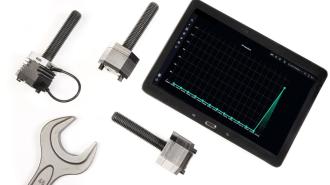Researchers in Germany have developed “smart” screws that can send out a warning when they begin to loosen, allowing them to be monitored remotely — hopefully reducing the time and effort of inspection and averting catastrophe.
The team developed a washer with a very thin pressure sensor attached to it. When the screw is first tightened, the sensor takes its baseline measurement. If that pressure were to decrease, the sensor sends out a warning.
Researchers have developed “smart” screws that can send out a warning when they begin to loosen, allowing them to be monitored remotely.
“This remote monitoring system allows us, for the first time, to keep an eye on the stability of safety-critical infrastructures at all times, even remotely, and to carry out a proper check on every single relevant screw,” the Fraunhofer Institute’s Peter Spies said.
“This is a major asset in terms of safety. When inspecting a bridge or wind turbine, no engineer is required to be on site and check each screw individually, as all the data are transmitted via radio to the service station.”
Under pressure: The system is underpinned by a thin, pressure sensitive material called DiaForce, previously developed at Fraunhofer. The sensor measures the pressure of the freshly tightened screw at three different points. Any pressure change alters the electrical resistance in the DiaForce.
When the sensor feels the screw may be loosening, that resulting resistance change gets transmitted to a radio module on the screwhead.
“The radio module, in turn, sends the data to a base station, which collects the information from all relevant screws in the object,” Spies said.
The information is relayed via a low-power wide-area network (LPWAN) protocol, which can send small amounts of data over long distances with little energy. A thermoelectric generator built into the system uses the temperature difference between the screw and its surroundings to generate the minimal power necessary.
The sensor measures the pressure of the freshly tightened screw at three different points. When the sensor feels the screw may be loosening, a warning gets transmitted via a radio module on the screw head.
Once the information arrives at the monitoring station, software turns the status of each screw into a graphic display.
To protect the system from cyberattack, each screw component is placed in a shielded box during installation. The box uses RFID to give each screw an ID number and encryption key, and the transmissions to the monitoring station are encrypted as well.
“This is how we prevent criminals or hackers from sabotaging the system. The technical staff who monitor a wind turbine, for example, can really rely on the data,” Spies said.
A screw loose: The state of American infrastructure is… not great.
In their latest quadrennial report card, the American Society of Civil Engineers gave the country a C-, which may fly for organic chemistry but not for critical infrastructure. ASCE says that there are 178 million trips taken daily across “structurally deficient” bridges — and although these bridges aren’t at risk of collapse, they do have maintenance issues that require extra supervision lest they become unsafe.
“When inspecting a bridge or wind turbine, no engineer is required to be on site and check each screw individually, as all the data are transmitted via radio to the service station.”
Peter Spies
Tech like smart screws could help us keep a weather eye on aging infrastructure and target repairs where they are most urgent.
According to the researchers, the Smart Screw Connection is designed to be used with commercially available screws and bolts, and it can be used for a variety of applications, including the steel girder bolts in a skyscraper, rotors in a wind turbine, or for load-bearing on a bridge.
We’d love to hear from you! If you have a comment about this article or if you have a tip for a future Freethink story, please email us at [email protected].






